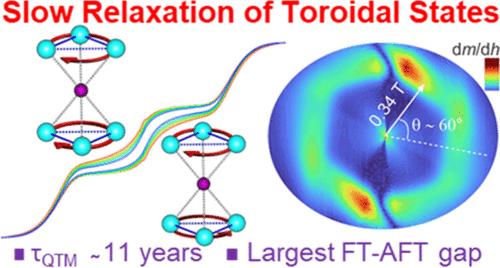环形镝配合物中环形态的超低弛豫
IF 15.6
1区 化学
Q1 CHEMISTRY, MULTIDISCIPLINARY
引用次数: 0
摘要
分子系统由于其独特的量子行为和结构可调性而成为量子信息科学(QIS)的新兴候选者,为下一代量子技术开辟了道路。虽然分子纳米磁体(MNMs)已经成为有前途的基于自旋的量子比特候选者,但实现长相干时间和可行的读数仍然具有挑战性。在分子纳米磁体中,单分子环体(smt)作为一个特别有前途的类别脱颖而出,提供了磁性沉默基态,以及独特的调节其固有手性的能力。在分子系统中实现环态仍然是一个重大的障碍,环铁(FT)矩的设计和稳定带来了更大的复杂性。此外,环形态预期的慢弛豫还没有得到明确的证明,这限制了它们在分子量子器件中的可行性。在这项工作中,我们报道了一个具有FT基态的三核[Ga7Dy6(N-mdea)6(ClCH2COO)6(NO3)6(OH)12(H2O)6]·3Cl(1)配合物。值得注意的是,该复合物显示出环形态的缓慢弛豫,首次实验观察到,磁化(QTM)的量子隧道弛豫时间为~ 3.5 × 108 s(~ 11年),远远超过了最先进的基于Dy(III)的单分子磁体的弛豫时间。μSQUID明确地建立了配合物1的鲁棒FT基态,并通过从头计算得到了证实,这标志着smt领域的重大进展。这种由淬灭的多体隧道过程产生的超低弛豫,为将环面态整合到量子技术中奠定了基础,并为QIS中的分子复合物提供了一种新的设计范式。本文章由计算机程序翻译,如有差异,请以英文原文为准。

Ultraslow Relaxation of Toroidal State in Ferrotoroidal Dysprosium Complex
Molecular systems are emerging candidates for quantum information science (QIS) due to their unique quantum behaviors and structural tunability, opening avenues for next-generation quantum technologies. While molecular nanomagnets (MNMs) have emerged as promising spin-based qubit candidates, achieving long coherence times and feasible readouts remains challenging. Among molecular nanomagnets, single-molecule toroics (SMTs) stand out as a particularly promising class, offering magnetically silent ground states, along with the unique ability to modulate their intrinsic chirality. Realizing toroidal states in molecular systems remains a significant hurdle, with the design and stabilization of ferrotoroidal (FT) moments posing an even greater level of complexity. Moreover, the anticipated slow relaxation of toroidal states has not been explicitly demonstrated, limiting their viability in molecular quantum devices. In this work, we report a tridecanuclear [Ga7Dy6(N-mdea)6(ClCH2COO)6(NO3)6(OH)12(H2O)6]·3Cl (1) complex, which exhibits an FT ground state. Remarkably, this complex shows slow relaxation of the toroidal states, experimentally observed for the first time, with a quantum tunneling of magnetization (QTM) relaxation time of ∼3.5 × 108 s (∼11 years), far surpassing the relaxation times reported for state-of-the-art Dy(III) based single-molecule magnets. The robust FT ground state in complex 1 is unequivocally established by μSQUID and corroborated by ab initio calculations, marking a major advance in the field of SMTs. This ultraslow relaxation, arising from quenched many-body tunneling processes, lays the foundation for integrating toroidal states into quantum technologies and offers a new design paradigm for molecular complexes in QIS.
求助全文
通过发布文献求助,成功后即可免费获取论文全文。
去求助
来源期刊
CiteScore
24.40
自引率
6.00%
发文量
2398
审稿时长
1.6 months
期刊介绍:
The flagship journal of the American Chemical Society, known as the Journal of the American Chemical Society (JACS), has been a prestigious publication since its establishment in 1879. It holds a preeminent position in the field of chemistry and related interdisciplinary sciences. JACS is committed to disseminating cutting-edge research papers, covering a wide range of topics, and encompasses approximately 19,000 pages of Articles, Communications, and Perspectives annually. With a weekly publication frequency, JACS plays a vital role in advancing the field of chemistry by providing essential research.

 求助内容:
求助内容: 应助结果提醒方式:
应助结果提醒方式:


